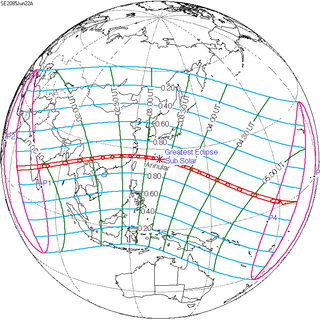| Solar eclipse of June 22, 2085 | |
|---|---|
| Type of eclipse | |
| Nature | Annular |
| Gamma | 0.0452 |
| Magnitude | 0.9704 |
| Maximum eclipse | |
| Duration | 209 s (3 min 29 s) |
| Coordinates | 26°12′N 131°18′E / 26.2°N 131.3°E |
| Max. width of band | 106 km (66 mi) |
| Times (UTC) | |
| Greatest eclipse | 3:21:16 |
| References | |
| Saros | 138 (35 of 70) |
| Catalog # (SE5000) | 9699 |
An annular solar eclipse will occur at the Moon's descending node of orbit on Friday, June 22, 2085,[1] with a magnitude of 0.9704. A solar eclipse occurs when the Moon passes between Earth and the Sun, thereby totally or partly obscuring the image of the Sun for a viewer on Earth. An annular solar eclipse occurs when the Moon's apparent diameter is smaller than the Sun's, blocking most of the Sun's light and causing the Sun to look like an annulus (ring). An annular eclipse appears as a partial eclipse over a region of the Earth thousands of kilometres wide. Occurring about 4.6 days before apogee (on June 26, 2085, at 16:30 UTC), the Moon's apparent diameter will be smaller.[2]
The path of annularity will be visible from parts of India, Myanmar, China, the Ryukyu Islands (including Okinawa), the Marshall Islands, and Kiribati. A partial solar eclipse will also be visible for parts of South Asia, Southeast Asia, East Asia, Oceania, and Hawaii.
- ^ "June 22, 2085 Annular Solar Eclipse". timeanddate. Retrieved 23 August 2024.
- ^ "Moon Distances for London, United Kingdom, England". timeanddate. Retrieved 23 August 2024.
